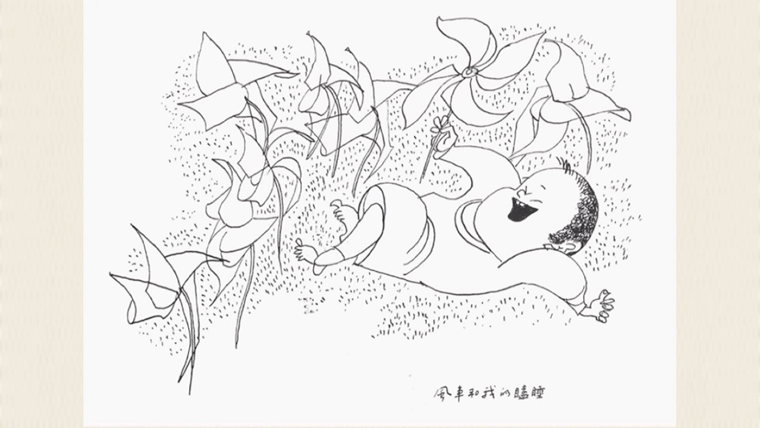由中国现代文学馆、作家出版社共同主办的“黄永玉诗和插画展”近日在北京闭幕,展览中展出了黄永玉先生《见笑集》中的诗歌、插画及部分手稿原件。《见笑集》收录的诗作是黄永玉过去几十年的积累,同时他自己也为这些诗配上了插画。现代文学馆馆长李敬泽认为,由黄永玉先生自己为自己的诗配画,“这是一个非常有意思的事儿”。

图:黄永玉作品《风车和我的瞌睡》
黄永玉1924年出生于湖南省凤凰县。曾做过瓷场工人、小学教员、报社美术编辑,后在美术学院任教,历任中国美术家协会理事、副主席,现为现为中央美术学院教授、中国国家画院研究员。他自学成才,从木刻为起点拓展至漫画、油画、国画、雕塑、工艺设计等领域,在中国当代美术界具有重要地位。同时,他还是一位作家、诗人,他的文字作品有的诙谐幽默却内涵深刻,有的凝练通透,有的则带有浓厚的故乡情结,字里行间充满真挚的感情。

图:黄永玉诗集《见笑集》
现代文学馆馆长李敬泽表示,许多儿童观众能对黄老先生的作品产生共鸣,他们能很好地理解这位爷爷对世界的看法,他的表达以及语言方式。这是因为他的作品充满了童趣与童心,是诗人在积累了多年后,在经历了诸多岁月往事之后,返璞归真的表达。

图:黄永玉在中国现代文学博物馆
时下,很多人对年龄、对未来充满了焦虑。
听听黄老先生怎么打破它:“我老不老干谁什么事啦?‘老’又不是我发明的,‘老’又不是我街上捡的”。
诸如此类“可爱”又充满智慧的诗作都记录在他的《见笑集》中。
周末到了,和我们一起沉下心,读一读大师的作品,品一品其中的人生滋味,感受黄老先生的乐观与豁达心态。

图:展览中播放黄永玉朗诵诗歌的视频
How do you imagine your life, when you’re well over 80 or even in your 90s? Well, for one renowned Chinese artist, it’s all about driving luxury motorcars, being splashed on fashion magazines, and having poetry collections published. But Huang Yongyu’s life wasn’t always so fast-paced. A self-taught artist, he’s better known for the primitive beauty of his wood prints and ink paintings. CGTN visited his exhibition in Beijing to learn more about his legendary vitality.
Titled Jian Xiao Ji, literally translated as ‘A Collection of Things that Incur Ridicule”, a new collection at the National Museum of Modern Chinese Literature contains dozens of poems which Huang penned over the course of seven decades. Some of the illustrations and excerpts are on their original manuscripts.
During a visit to the exhibition, Huang revealed that the illustrations were pure improvisation, he just took a stack of paper and drew on it.
He added that: “For this painting of Chinese writer Ba Jin, I forgot to draw the bridge joining the lenses of his glasses. I think someone may have added it later. It wasn’t there originally; then I found out about this.”
Huang was born in the central Chinese province of Hunan in 1924. He left his hometown of Fenghuang in his teens, and traveled around the country.
Pursuing his life-long dream, he took on a variety of jobs, learning all kinds of artistic skills along the way. Through an unusual mix of modernity and what he called “an aroma of soil” his work soon touched the lives of many.
When asked about what an artist’s mission should be, the maestro’s answer is to discover things which people don’t usually pay attention to. He went on, saying that: “When they see that from your works, they are simply amazed at why they don’t see something as simple and obvious.”
The unique charm of his works also extends overseas.
In the 1990s, Huang went to Europe, visiting cities like Paris and Florence, depicting different people and scenery along the way. He later brought the paintings and stories of his travel experiences together in his essay ‘Along the River Seine to Florence.’ First published in 2006 and also translated into Italian, it became a best-seller in China.
“Though cultural differences do exist, there’s a way to paint around it.” Huang expressed in his previous interviews. He noted he painted through a child’s point of view, just like the French painter Henri Rousseau who’s known for his primitive and naive style.
For Li Jingze, curator of the National Museum of Modern Chinese Literature, what’s most valuable about Huang’s work is that as someone who’s already in his nineties, he still exudes an incredible amount of creative energy, and that child-like innocence for this world and for his life. “In his eyes, the world is still fresh and bright.”
Both as an artist and as a human, Huang has lived his life to the fullest. And as the Mr Young-at-Heart stresses, the sky’s the limit and your best years are always ahead of you.
© 2022, biznews. All rights reserved.
